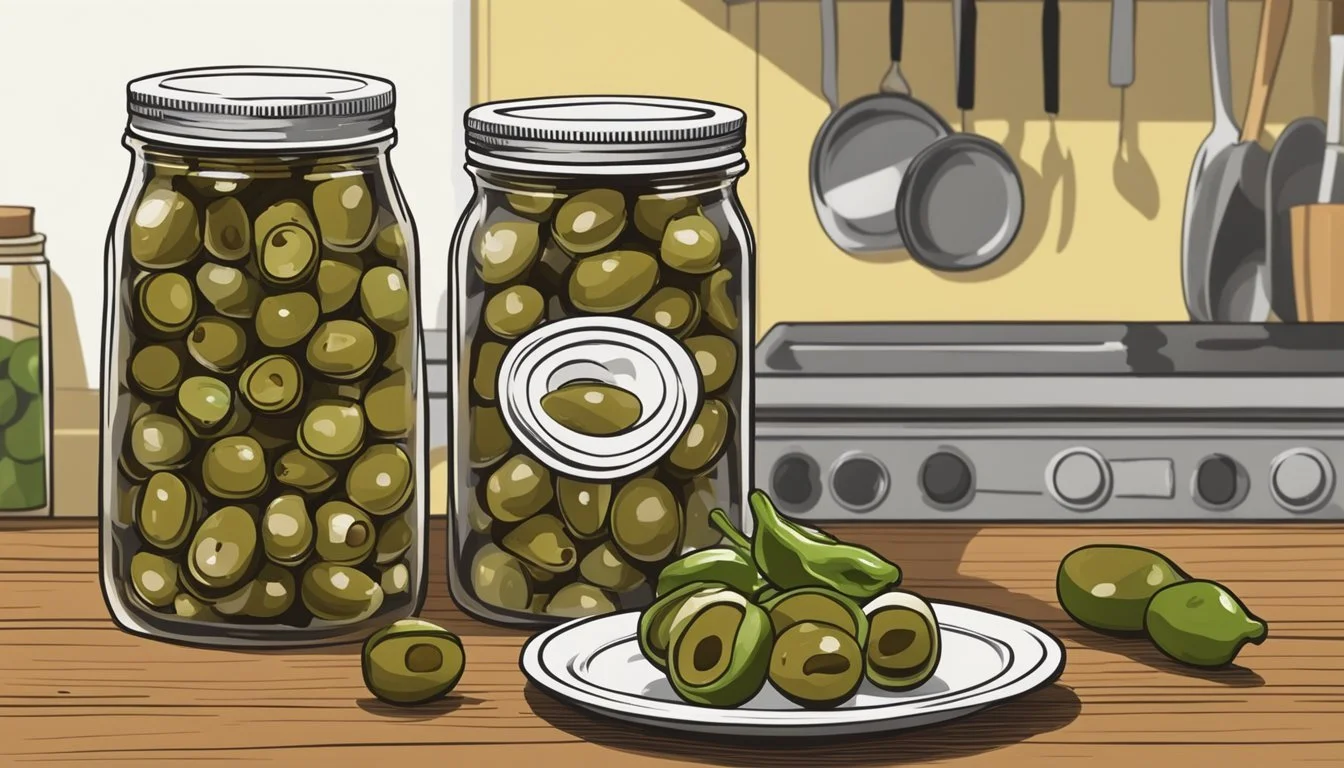Capers Substitutes
Top Alternatives for Your Recipes
Capers (What wine goes well with capers?) have a distinctive flavor that adds a burst of complexity to dishes with their salty and briny notes. They are often used in Mediterranean cuisine, appearing in recipes like chicken piccata, pasta puttanesca, and as a garnish for various fish dishes. While capers are loved for their unique taste, there are times when they may not be readily available or when someone might be looking for an alternative that suits their dietary restrictions or personal taste preferences.
To cater to such scenarios, there are several suitable substitutes that can mimic the flavor profile of capers or offer their own unique take. Green olives are a commonly recommended replacement due to their similar saltiness and acidity. They can be chopped to approximate the size of capers. Other alternatives, such as thyme, offer a different flavor angle with a hint of bitterness and a citrus note suited for slow-cooked dishes. Each substitute brings its own characteristics to the table, and understanding the nuances of their flavors can help in choosing the right one for a particular recipe.
Understanding Capers
Capers are small, unripe flower buds that come from the Capparis spinosa, commonly known as the caper bush. This perennial plant is native to the Mediterranean and thrives in harsh conditions, often found rooted in rocky crags and crevices. Capers are known for their distinctive flavor profile—a combination of salty, tangy, and floral notes—which makes them a popular addition to various dishes such as salads, pizzas, pasta, and fish recipes.
When harvested, capers are typically dark green and vary in size, with non-pareil capers being the smallest and most sought after for their superior texture and taste. The buds are often pickled or salted to enhance their natural flavors and to preserve them for culinary use.
Caper berries are the fruit of the caper bush and are larger than caper buds. Often pickled as well, they offer a milder taste compared to their smaller counterparts, and can be included in meals as a flavor enhancer.
Here's a summary of caper characteristics:
Feature Description Source Capparis spinosa (caper bush) Size Varieties Non-pareil (smallest), others vary Taste Salty, tangy, floral Preservation Pickled, salted
It's essential to recognize that the unique flavor of capers cannot be precisely replicated, but understanding their culinary role is key when seeking suitable substitutes.
Common Capers Substitutes
Choosing the right substitute for capers greatly depends on achieving a similar burst of tanginess and saltiness that capers provide. The following options vary in flavor intensity, but each can offer a distinct touch to dishes where capers are traditionally used.
Green Olives and Varieties
Green olives can be chopped to mimic the size of capers and offer a comparable saltiness and tang. Varieties like Kalamata olives or black olives also serve as appropriate replacements but will impart a fruitier, less tangy flavor to dishes.
Pickles and Pickled Items
Pickles, especially dill pickles, cornichons, and gherkins are excellent substitutes, delivering a similar crunch and acidity. Pickled onions, both red and white, can be minced to approximate caper size, lending both a tangy flavor and a crisp texture.
Other Vinegar-Based Substitutes
Alternatives like pickled green peppercorns or caperberries are less common but offer a similar piquancy to capers. While caperberries are milder and larger, pickled green peppercorns bring a sharp peppery bite.
Citrus Flavors
Lemon or lime juice can provide the acidity that one expects from capers, although without the characteristic texture. Preserved lemons finely chopped can also act as a caper stand-in, particularly in Mediterranean dishes.
Fresh and Dried Herbs
Aromatic herbs such as fresh thyme, dried thyme, basil, or tarragon can replace capers to impart an earthy or slightly bittersweet taste. They are best used in cooked dishes where their flavors have time to develop.
Additional Substitutes
Other ingredients like anchovies, (What wine goes well with anchovies?) artichoke hearts, and nasturtium seeds are less conventional alternatives that can replicate caper’s unique profile. Anchovies add umami and a saline note; artichoke hearts lend a subtle taste and tender texture; and nasturtium seeds provide a peppery kick.
Flavor Profiles and Pairings
In the culinary world, capers are renowned for their distinct taste profile and versatile pairings. They can enhance a dish with a burst of flavor resembling a cross between olives and lemon. In substituting capers, it’s important to consider how alternatives might emulate these prominent flavor notes and pair with other ingredients.
Salty and Briny
Capers are known for their salty and briny flavors, derived from the curing process in salt or brine. This makes them a staple in Mediterranean cuisine. To replicate the briny taste, green olives can be chopped finely and used as a caper substitute, bringing a similar saltiness to dishes. Sea salt flakes or black pepper can also be sprinkled sparingly to mimic the caper's intrinsic salinity.
Sour and Tangy
The sour and tangy dimensions of capers are notable, pairing exceptionally well with fish and pasta. Substitutes like chopped dill pickles or artichoke hearts provide a comparable zesty flavor. Incorporating these alternatives into sauces or salads should be done with consideration to their acidic quality, which can liven up a recipe similar to capers.
Bitter and Herbaceous
The slight bitterness of capers is often balanced with other flavors in a dish. Caper berries, larger than capers, share this bitter characteristic but with a milder intensity. Pairing with fresh herbs like dill can complement and subtly mitigate the bitterness, while adding an earthy, herbaceous layer to dishes.
Umami and Anchovy
In dishes requiring umami, capers contribute a savory complexity akin to that of anchovies. When seeking a substitute for capers to invoke umami, chopped anchovies are an excellent choice. They should be used sparingly to infuse the dish with a deep, rich, and savory flavor without overpowering other tastes.
Culinary Applications
Capers, known for their distinctive salty and tangy flavor profiles, are often integral to many recipes. The following substitutes for capers can be incorporated effectively in various culinary applications, maintaining the essence of the dish.
Sauces and Dressings
For sauces like tartar sauce, pickled gherkins minced finely can replace capers, reflecting a similar brininess. Green olives, when chopped and scaled down, contribute the needed acidity in replacement of capers, maintaining the characteristic piquancy in dressings.
Salads and Vegetables
In salads and vegetables, the substitute must invoke the same zest that capers provide. Dill pickles, diced into small pieces, offer a herbal tang to salads. When considering veggies, one can opt for chopped caperberries, albeit larger, for a comparable taste with a milder flavor.
Pasta Dishes
Pasta, particularly pasta puttanesca, is enriched with capers' unique savor. As a substitute for capers in pasta, green olives can be used in a 1:1 ratio; their salty, oily, and acidic notes mirror those of capers, enhancing the overall flavor complexity without overwhelming the dish.
Protein Accompaniments
For proteins such as fish in chicken piccata or tuna dishes, substitutes should complement without overpowering the main ingredient. Chopped green olives achieve the salty and bitter notes capers impart, ideal for garnishing or being mixed into sauces that accompany these proteins.
Storing and Preparation Tips
When it comes to storing capers and their substitutes, one must pay close attention to both the environment and containers used. For capers, the key to longevity is keeping them submerged in their brine. One should store them in a cool, dark place such as a refrigerator. This method ensures that the capers remain fresh and flavorful for an extended period.
Substitutes such as green olives or gherkins should also be stored in their respective brines and refrigerated after opening. If one is preparing a substitute like pickled nasturtium seeds, they must ensure that the seeds are completely covered in vinegar or a vinegar-olive oil mixture before sealing and refrigerating.
In terms of preparation, olive oil plays a crucial role in preserving the character of these substitutes. When using olives or gherkins, it's beneficial to chop them into pieces comparable in size to capers to mimic the texture and distribute their intense flavor evenly.
For a substitute such as red or white wine, the choice depends on the dish. White wine offers a delicate acidity and is excellent for seafood or chicken dishes, while red wine provides a more robust flavor that stands up well in red meat dishes.
Substitute Storage Condition Preparation Tip Capers Refrigerated in brine Use directly from the jar Olives Refrigerated in brine Chop to size; add to salads or main courses Wine Cool, dark place Use in sauces or as a deglazing liquid Gherkins Refrigerated in brine Dice finely; use as a garnish or in salads
By adhering to these storage and preparation tips, one can ensure that the essence of capers – or a chosen substitute – is captured and maintained, enhancing the overall flavor of the culinary creation.
Frequently Asked Questions
In this section, readers will find detailed information about the distinct characteristics of capers and how to substitute them effectively in various recipes.
Characteristics of Capers
Capers are the unopened flower buds of the Capparis spinosa plant, typically used as a culinary ingredient. They are known for their piquant flavor that can be described as tangy, lemony, and salty. This flavor profile is often thanks to their pickling process in brine or wine vinegar. Capers are categorized by size, with non-pareil capers being the smallest and most desirable due to their more delicate texture and flavor, contrasting with the larger caper berries which contain seeds and have a milder taste.
Substitution Measures
When substituting capers, consider the following options to mirror their distinctive taste:
Green Olives: Green olives are salty and acidic, making them a suitable substitute. They should be chopped to resemble the size of capers.
Ratio: 1:1
Dill Pickles: These offer a similar vinegary punch. Finely diced, they can stand in for capers in most dishes.
Ratio: 1:1
Each substitute should be used in accordance with the caper's role in the recipe—whether as a dominant flavor or a subtle accent. Adjust the amount based on taste preference and the salt content of the dish.







